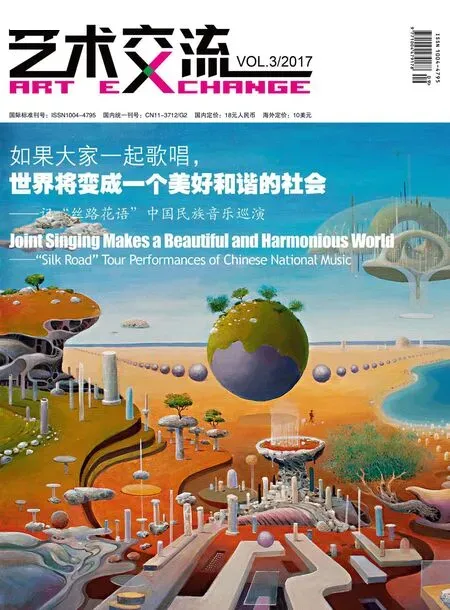青年书法,在俄罗斯展现“汉字之美”
2017-03-16吴悠WuYou王彦WangYan曹宇光CaoYuguang
文吴悠 Wu You 图王彦 Wang Yan 译曹宇光Cao Yuguang
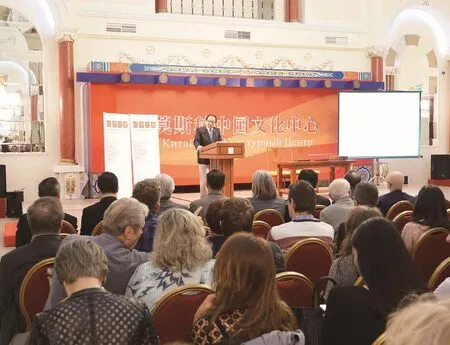
“汉字之美”展览开幕式现场Opening Ceremony of the Exhibition Titled “Beauty of Chinese Characters”
9月11日至16日,由中国文联、中国书协主办的“汉字之美”——中国青年书法家作品展在俄罗斯莫斯科中国文化中心举办。这是继联合国教科文组织将中国书法列为世界非物质文化遗产之后,该展览相继在法国巴黎联合国教科文组织总部、澳大利亚、墨西哥、加拿大、葡萄牙、比利时欧盟总部等地举办以来的又一次书法展览盛会。中国文联副主席、中国文联代表团团长李屹,中国书协副主席何奇耶徒,驻俄罗斯使馆文化处参赞龚佳佳、莫斯科中国文化中心副主任李峙,以及莫斯科市杜马、俄罗斯艺术科学院苏里科夫美术学院、俄罗斯克拉斯诺达尔国立文化艺术学院、国立列宁图书馆负责人等100多位俄罗斯专家学者、艺术家、媒体和观众出席了展览开幕式。
本次展览展出了中国当代39位青年书法家创作的以中国古代的诗词文赋、名言名句为内容的书法作品。作品多书体、多形式地展示和呈现了中国古代哲思传统与书法艺术独特的中国之韵、中国之美,以及当代青年书法家对独具中国美学精神的书法艺术的传承和探索。
“俄罗斯是一个美丽的国度,也是一个文化大国,领土跨越欧亚两洲,融合了东西方两种文化。历史上涌现出了许多杰出的艺术大师,在世界艺术上产生着重大的影响。而中国是书法艺术的母国,书法在中国是一门非常独特的传统艺术,有着深厚的文化底蕴和群众基础。博大精深、异彩纷呈的传统书法艺术,已经成为中国向世界展示国家形象的精彩名片。”何奇耶徒介绍说。他表示,多年来,中国文联和中国书协推出的“汉字之美——中国书法展”系列活动,积极传播书法艺术,面向世界架设起一条书法艺术的友谊桥梁,在弘扬中国传统文化、推动中国传统文化艺术的海外传播、加强国际间的艺术交流方面,发挥了积极作用,取得了显著成效。
龚佳佳说,与俄罗斯的字母文字不同,中国文字是表意象形文字,有着十分悠久的历史,经历了漫长的演变。从最初的甲骨文到金文,从篆书到隶书,渐次到我们今天的汉字,书写的材料从龟壳到青铜器、到竹简、到帛书、到中国汉字独有的宣纸,书写的工具从刻刀到毛笔,但无论汉字怎样演变,它具有惊人的延续性和连贯性。今天的中国人依然可以读懂几千年以前中国的史书典籍,与我们的祖先对话。这在世界文字史上是十分罕见的。随着汉字的创立、发展、成熟,中国书法作为一门独立的艺术出现了,它的发展历史与中国文字的发展历史息息相关。“书法是线条的艺术,是中华文化的独特瑰宝。中国知识分子认为‘字如其人,字由心生’,也就是说,一个人要写得一笔好字,不仅要技法上刻苦练习,更加重要的是写字的人需要磨练自己,完善自己,达到内心的和谐,这样写出来的字才有气韵,才有境界。从今天我们展出的作品,观众朋友们可以从中看到中国书法的不同字体和风格,感受到汉字之美、书法之美、中国文化之美。”她说。
莫斯科市杜马文化、大众传媒委员会首都文化艺术家协调委员会副主席朗茨曼从中俄两国文化交流的角度针对我们的书法展给予了高度评价,他强调书法展可以让更多俄罗斯人认识熟悉这一中国特有艺术门类的功能。俄罗斯艺术科学院苏里科夫美术学院教授、人民画家彼得罗夫表示,中国书法对他在艺术创作过程中的启发和书法的线条美和韵律美。俄罗斯科学院东方研究所中国处主任柯布泽夫认为,中国书法是世界上独一无二的融合艺术与文字的文化现象,这在欧洲和俄罗斯这种以字母为文字载体的文化背景下不那么容易理解;所以他还向在场观众重点讲解了中国书法和汉字进化之间的关系,以及中国书法以黑白成像创造艺术美感的功效。
“国之交在于民相亲,民相亲在于心相通。”通过“汉字之美”——中国青年书法家作品展这样的活动,将有助于建立中俄文化交流的平台,加深双方的文化了解,持续推动中俄两方人民对话,增进双方人民友谊,加强两个伟大文明的互动。

彭双龙作品Calligraphy by PENG Shuanglong
From September 11 till 16, “Beauty of Chinese Characters”Chinese Youth Calligraphers’ Works Exhibition sponsored by CFLAC and China Calligraphers Association (CCA) was held at Chinese Culture Center at Moscow of Russia. In the wake of UNESCO’s listing Chinese calligraphy into the World Intangible Cultural Heritage, this exhibition has become another calligraphy gala in Moscow after its sessions in the UNESCO Headquarters in Paris of France, Australia, Mexico, Canada, Portugal and EU Headquarters in Belgium. Distinguished guests such as LI Yi,executive vice president of CFLAC and head of CFLAC delegation,HE Qiyetu, vice president of CCA, GONG Jiajia, cultural counselor of Chinese Embassy in Russia, LI Zhi, deputy director general of Chinese Culture Center at Moscow, as well as over 100 experts,scholars, artists and representatives from Municipal Duma of Moscow, Surikov Fine Arts Academy of Russian Academy of Arts,Krasnodar State Academy of Culture and Arts and State Lenin Library, along with local media and audiences, attended the opening ceremony.
This exhibition involves calligraphy in the contents of ancient Chinese poetry, prose and mottos created by 39 contemporary Chinese young calligraphers. In multiple types and styles of calligraphy, their works highlight the ancient tradition of Chinese philosophy, the unique attraction of Chinese calligraphic art and the contemporary young artists’ inheritance and exploration of Chinese calligraphy as a carrier of Chinese aesthetic spirits.
“Russia is a beautiful country as well as a cultural power in the world. Its geographic coverage on both Asia and Europe leads to the integration of two civilizations of Orient and Occident.Thanks to the constant occurrence of many masters in arts in history, Russia exerts a significant impact upon the global arts.China is the motherland of calligraphic art, As a particular traditional art, chinese calligraphy is blessed with a solid foundation in culture and enjoys extensive participation. Chinese calligraphy of profound connotation and colorful presentation has become an excellent name card of China that demonstrates its national image to the rest of the world.”HE Qiyetu concluded.As far as he can see,the “Beauty of Chinese Characters—Chinese Calligraphy Exhibition”series sponsored by CFLAC and CCA in recent years have managed to disseminate this art in an active way and establish a friendship bridge to connect the world in calligraphic art. Moreover, in the respect of promoting traditional Chinese culture both at home and abroad,and enhancing international art exchange and communication,this series have played positive role and achieved remarkable in fluence.
As GONG Jiajia, cultural counselor of Chinese Embassy in Russia put, different from the alphabetic letters of Russian language,Chinese characters, as a time-honored ideographic language, have undergone a prolonged evolution from the initial inscriptions on bones and shells of tortoise to that on bronze objects, then to seal characters and official scripts, and finally to the current standard scripts. Despite the change of either writing materials from bronze to bamboo, from silk to paper, or writing tools from graver to brush, Chinese characters have maintained amazing continuity and coherence. Today’s Chinese people are still able to read through those ancient classics of thousands of years ago and conduct dialogues with their ancestors, which is quite rare in the world linguistic history. Along with the establishment,development and maturity of characters, Chinese calligraphy becomes an independent art and shares its own development process closely bound up with that of Chinese language.“Calligraphy is an art of lines. It is a unique treasure of Chinese culture. Chinese intellectuals insist that a person’s calligraphy is a reflection of his or her personality. In other words, to achieve a perfect calligraphy, one must not only keep perseverant practice with writing skills, but also keep perfecting internal harmony and virtue. Viewers can feel momentum and wisdom from a person’s calligraphy as well. Therefore from this exhibition, Russianaudiences can appreciate the varied forms and styles of Chinese calligraphy and experience the beauty of chinese characters,chinese calligraphy and Chinese culture.” she said.
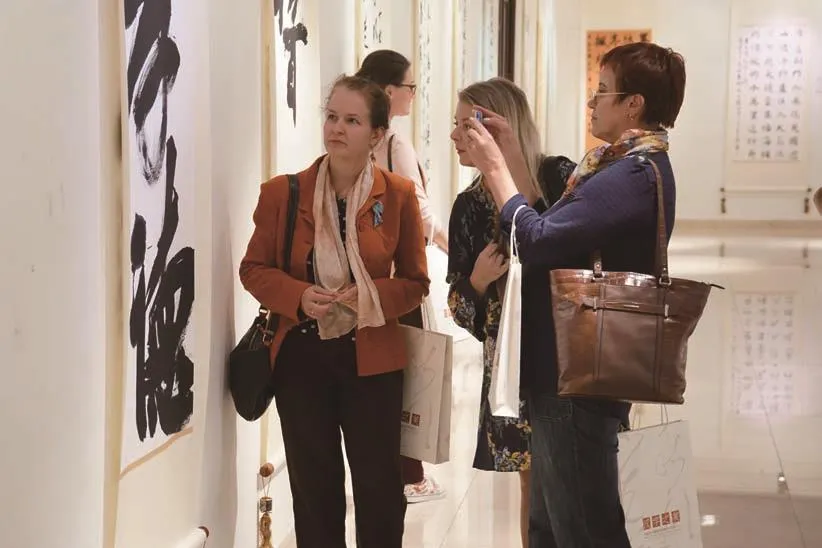
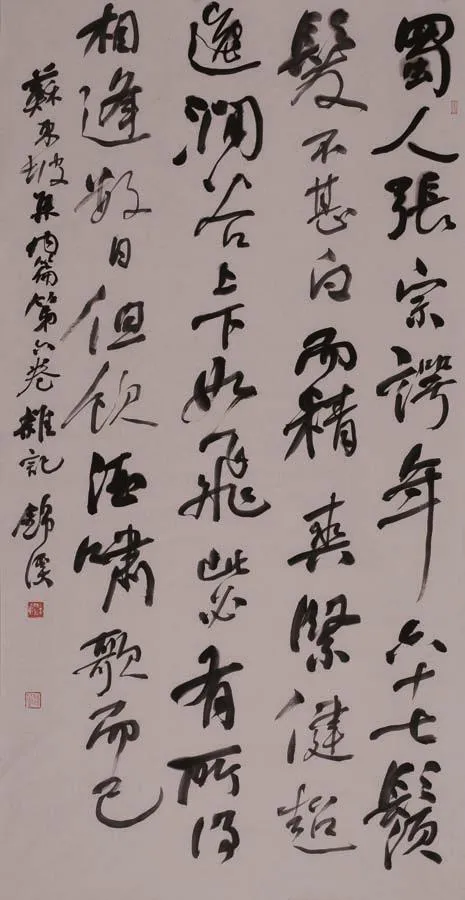
曾锦溪作品Calligraphy by ZENG Jinxi
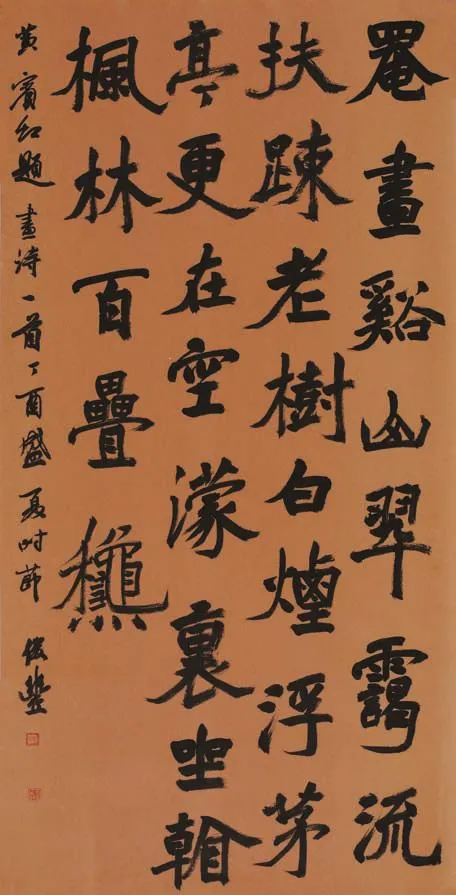
提俊丰作品Calligraphy by TI Junfeng
From the perspective of cultural exchange between China and Russia, Lanzman, vice chair of capital cultural artists coordination committee of Culture, Social Media Committee of Moscow Duma, spoke highly of this Chinese calligraphy exhibition and stressed that this exhibition may bring more Russian people into familiarity with this particular Chinese art discipline. As Pedrov,professor and People’s painter from Surikov Fine Arts Academy of Russian Academy of Arts expressed, during the course of his artistic creation, Chinese calligraphy inspired him with the beauty of lines and rhythm. In the opinion of Kobzev, director of Chinese studies at Oriental Research Institute of Russian Academy of Science, Chinese calligraphy is the unique cultural phenomenon of art and language integration, and thus hard for those in the cultural background of letter languages in Europe and Russia to fully understand. In this case, he deliberately gave a lecture to Russian audiences about the relationship between Chinese calligraphy and characters as well as the aesthetic effect of black-and-white calligraphy.
As Chinese President Xi Jinping remarks, “frequent exchanges are essential to amity between peoples which in turn is the key to sound relations between states”. Such event as“Beauty of Chinese Characters” Chinese Youth Calligraphers’Works Exhibition will help establish a strong platform of cultural exchange between China and Russia, deepen mutual understanding of each other’s cultures, promote dialogue and friendship between the two peoples and enhance the interaction between the two civilizations.
